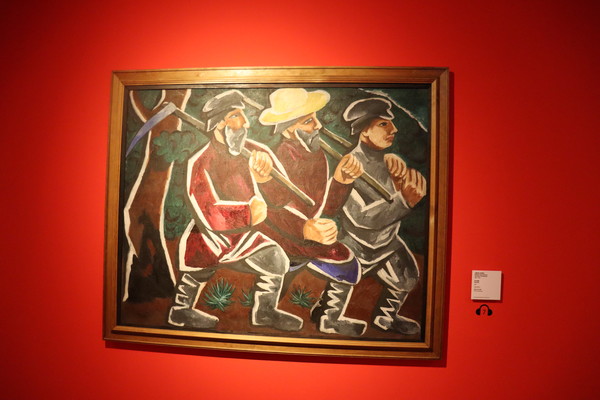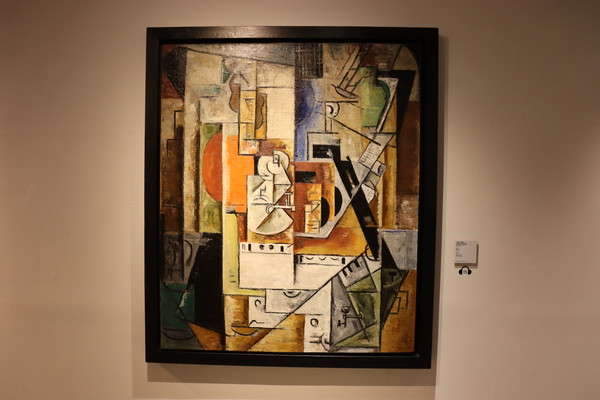An exhibition set in the most revolutionary era in Russian art history is waiting for you. The exhibition <Kandinsky, Malevich & Russian Avant-Garde> presents 75 paintings by 49 Russian avant-garde artists, including Kandinsky and Malevich. Avant-garde is well known as a fashion term. It refers to a difficult and bizarre design. The avant-garde movement in Russian art history has a similar meaning, and it is a movement in which artists sought innovation by overturning existing art ideas or forms during the early 20th-century art revolution. This exhibition consists of six sections under the theme of Russian avant-garde art. If you feel unfamiliar with Russian art, it would be nice to take a closer look at the history of Russian avant-garde art through this exhibition. Let's dive into the exhibition <Kandinsky, Malevich & Russian Avant-Garde> with CAH.
The Birth of the Russian Avant-Garde

From the beginning of the exhibition hall, the red wall overwhelms the atmosphere. This makes us look forward to works full of Russian artists' passion. In the first section, you can view artworks on symbolism[1], post-impressionism[2], and expressionism[3] from the 1910s, which are the beginning of Russian avant-garde art. The most eye-catching work was Mikhail Larionov's <Jewish Venus>. Venus, as is commonly known, is a symbol of beauty. However, Mikhail Larionov's Venus is somewhere different from the traditional Venus we know. Socks marks remain under her knees. Her drowsy expression shows no shame and rather looks confident. Western art pursued spotless perfection to maximize the beauty of Venus. However, he rather maximized naturalness by leaving flaws in the painting and made new attempts against ordinary aesthetics.
Natalia Goncharova's <The Chaser> is a familiar piece of art. <The Chaser> is made of traditional Russian engraving, Lubok, and the outline is clearly expressed like a woodblock. The use of distinct outlines and fewer colors makes the picture neat without unnecessities. In addition, the appearance of the three miners filling the work looks dignified and courageous. Goncharova is said to have tried to create new art in Russia through the crude and affectionate expression technique of Lubok. Her attempt is meaningful as a movement to find the essence so that the working class can enjoy Russian art, which had been enjoyed only by the elite.
From Figurativeness to Abstractness

In the mid-1910s, it is said that the main concern of Russian avant-garde artists was to overcome time and space constraints. Russian avant-garde artists tried to capture the movement and the passage of time behind objects that were not visible at one point in time. This created a new trend of “Russian Futurism.” Nadezda Udalchova's <Kitchens> is a mysterious work. He seems to be asking the question of where to find the kitchen in the work. In the picture, objects such as colorful faucets, tables, boxes with handles, and vents are divided and scattered like puzzle pieces. In a brown background, connecting all the pieces of objects scattered like a puzzle will remind you of a kitchen image. Aren't these things that aren't in their original place fresh? You will be able to get a new perspective on things through the placement of different objects. These various viewpoints and new arrangements of objects correspond to the main point in this section, Russian Futurism.
The Emergence of Abstract Paintings

In this section, you can enjoy the works of Wassily Kandinsky and Kazimir Malevich, the main artists of the exhibition. They drew abstract paintings with a tendency to be counterfactual, but the styles were slightly different from each other. Kandinsky uses an expressionist abstract style and painted based on emotion through three stages: improvisation, impression, and composition. Malevich painted using absolutistic abstract styles and geometric elements. The point of Kandinsky's <Improvisation No.4> is simplicity and vivid color. The contrast between the colors of the trees, forests, people, and the sunset sky stands out, and the roughly expressed brush marks are clearly visible. As the title of "Improvisation," it seems that Kandinsky drew an image that unconsciously came to mind.
Malevich's <The Lady Playing the Piano> is also a very sensational piece. From the title alone, it is expected that it will be a picture of a woman playing the piano. However, no piano or woman can be found in the picture. In the orange background, elements symbolizing sheet music, musical paper and notes are placed in a dizzying way. And the black square in the middle looks like a piano. Since Malevich mainly used a lot of geometric elements in the painting, you may find it difficult to intuitively grasp the picture. However, if you connect the elements of the artwork, you will clearly see a woman playing the piano. Both Kandinsky and Malevich drew abstract paintings, but you can also feel that there is a difference in paintings due to the different elements used. Kandinsky's painting has a rough brush texture and an unclear boundary between lines and lines. On the other hand, Malevich's work has a clear boundary between lines and lines with a light brush texture. In addition, many shapes can be found in his artworks.
In the exhibition <Kandinsky, Malevich & Russian Avant-Garde>, you can enjoy Russian avant-garde works of art that attempted reform in defiance of the existing Western art in the early 20th century. In addition, there are many works that have broken our expectations beyond the existing framework. They provide us an opportunity to look at the work from a new perspective. Are you ready to fall into the new charm of Russian avant-garde art? Welcome to the center of the artistic revolution, <Kandinsky, Malevich & Russian Avant-Garde>
Dates: 2021.12.31. (Friday) ~ 2022.04.17. (Sunday)
Hours: 10:30-19:30 (The last entrance 19:00) (Open all year round)
Place: Sejong Museum of Art
Ticket Prizes: 20,000 won for adults (19 years old to 64 years older) / 15,000 won for teenagers (13 years old to 18 years old) / 13,000 won for children (7 years old to 12 years old) / 8,000 won for special ticket (4 years old to 6 years old and over 65 years old / Free for less than 48 months
Contact: 02-724-2616
[1] Attitude or tendency to implicitly express certain sentiments or emotions in symbolic ways.
[2] Attitudes and tendency that value subjective expressions and use extremely simple techniques.
[3] Artistic trends that focus on expressing subjective emotions and reactions caused by objects or events rather than objective facts.

